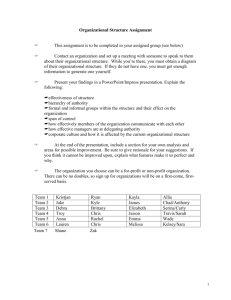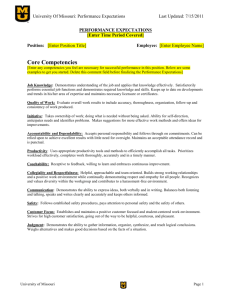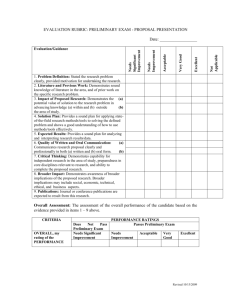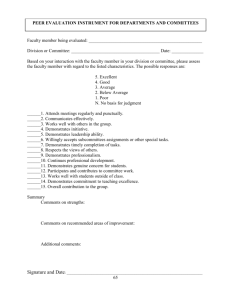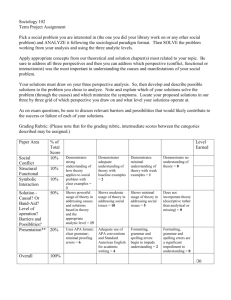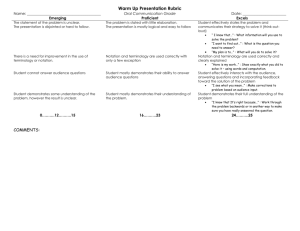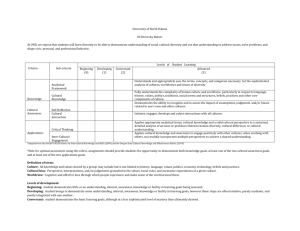MIS
advertisement
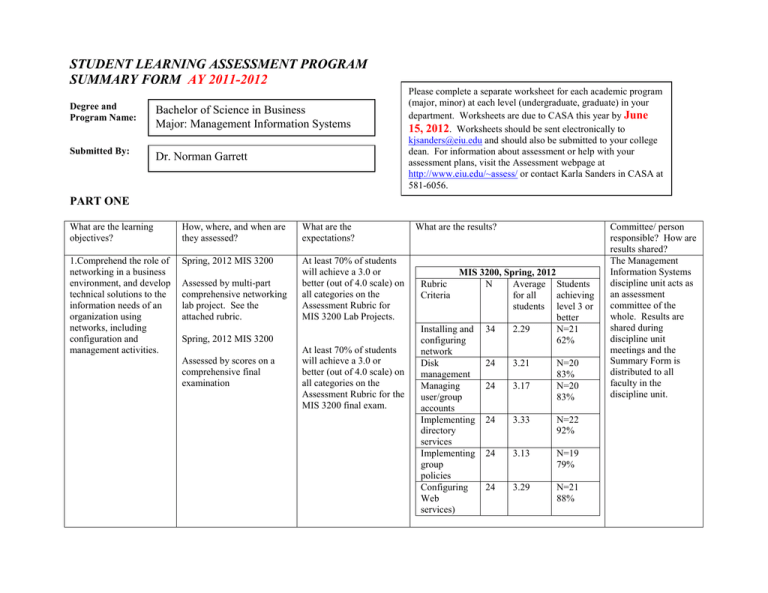
STUDENT LEARNING ASSESSMENT PROGRAM SUMMARY FORM AY 2011-2012 Degree and Program Name: Bachelor of Science in Business Major: Management Information Systems Submitted By: Dr. Norman Garrett Please complete a separate worksheet for each academic program (major, minor) at each level (undergraduate, graduate) in your department. Worksheets are due to CASA this year by June 15, 2012. Worksheets should be sent electronically to kjsanders@eiu.edu and should also be submitted to your college dean. For information about assessment or help with your assessment plans, visit the Assessment webpage at http://www.eiu.edu/~assess/ or contact Karla Sanders in CASA at 581-6056. PART ONE What are the learning objectives? How, where, and when are they assessed? What are the expectations? 1.Comprehend the role of networking in a business environment, and develop technical solutions to the information needs of an organization using networks, including configuration and management activities. Spring, 2012 MIS 3200 At least 70% of students will achieve a 3.0 or better (out of 4.0 scale) on all categories on the Assessment Rubric for MIS 3200 Lab Projects. Assessed by multi-part comprehensive networking lab project. See the attached rubric. Spring, 2012 MIS 3200 Assessed by scores on a comprehensive final examination At least 70% of students will achieve a 3.0 or better (out of 4.0 scale) on all categories on the Assessment Rubric for the MIS 3200 final exam. What are the results? MIS 3200, Spring, 2012 N Average Students for all achieving students level 3 or better Installing and 34 2.29 N=21 configuring 62% network Disk 24 3.21 N=20 management 83% Managing 24 3.17 N=20 user/group 83% accounts Implementing 24 3.33 N=22 directory 92% services Implementing 24 3.13 N=19 group 79% policies Configuring 24 3.29 N=21 Web 88% services) Rubric Criteria Committee/ person responsible? How are results shared? The Management Information Systems discipline unit acts as an assessment committee of the whole. Results are shared during discipline unit meetings and the Summary Form is distributed to all faculty in the discipline unit. MIS 3200, Spring, 2012 Rubric Criteria N Average Students for all achieving students level 3 or better Understanding 24 3.13 N=20 of the OSI and 83% the TCP/IP models including encapsulation Knowledge of 24 3.21 N=20 internetworking 83% devices Understanding 24 3.25 N=21 of data and 88% signal transmission Knowledge of 24 3.21 N=20 physical and 83% wireless media Understanding 24 3.29 N=21 of the Internet 88% operation and IP addressing 2.Demonstrate competent problem-solving and logical skills. Fall, 2011 MIS 2000 Spring, 2012 MIS 2000 Assessed by series of 4 homework assignments, each of which test different criteria on the Assessment Rubric for MIS 2000— Homework Assignments 14. See the attached rubric for which homework assignments test which criteria. At least 70% of students will achieve a 3.0 or better (out of 4.0 scale) on all categories on the Assessment Rubric for MIS 2000—Homework Assignments 1-4. MIS 2000, Fall, 2011 Homework Rubrics Rubric Criteria n Average Students for all achieving students level 3 or better Logical 31 3.68 N=30 Reasoning 97% Problem 31 3.71 N=30 solving 97% Logic 31 3.71 N=30 development 97% Program 31 2.97 N=23 The Management Information Systems discipline unit acts as an assessment committee of the whole. Results are shared during discipline unit meetings and the Summary Form is distributed to all faculty in the discipline unit. documentation Program requirements Record processing 74% N=30 97% N=25 81% 31 3.68 31 3.06 Looping constructs 31 2.45 N=20 65% Modularization techniques 31 2.97 N=23 74% Identify user decisions 31 3.61 N=29 94% MIS 2000, Spring, 2012 Homework Rubrics Rubric Criteria n Average Students for all achieving students level 3 or better Logical 27 3.67 N=24 Reasoning 89% Problem 26 3.77 N=25 solving 96% Logic 26 3.81 N=25 development 96% Program 26 2.77 N=23 documentation 88% Program 26 3.77 N=24 requirements 92% Record 31 2.48 N=17 processing 55% 3.Analyze, design, develop and implement a business information system by using system development methodologies and enterprise databases. Spring, 2012 MIS 4200 Assessment by a comprehensive multi-part systems and database project which runs throughout the semester. See the attached rubric. At least 70% of the teams will achieve a 3.0 or better (out of 4.0 scale) on all categories on the Assessment Rubric for MIS 4200 Database Project. Looping constructs 28 2.54 N=15 54% Modularization techniques 29 2.24 N=14 48% Identify user decisions 32 3.76 N=24 92% MIS 4200, Spring, 2012 Team Projects Rubric n Average Students Criteria for all achieving students level 3 or better SDLC 32 3.34 N=29 Deliverables 91% Process 32 3.28 N=28 diagrams 88% Logical data 32 3.25 N=27 models 84% Relational 32 3.28 N=28 principles 88% Human 32 3.28 N=28 Interface 88% Design Programming 32 3.25 N=27 logic 84% constructs Multiple program application 32 3.28 N=28 88% Systems and user documentation 32 3.16 N=27 84% The Management Information Systems discipline unit acts as an assessment committee of the whole. Results are shared during discipline unit meetings and the Summary Form is distributed to all faculty in the discipline unit. 4. Develop technical solutions to information system needs of an organization in a multiplatform environment. 5. Analyze and design enterprise-level networks including security and network management. Spring, 2012 MIS 4330 This objective applies only to students who are majoring in MIS in the Programming track. Each programming language has a two-course sequence. The second course is assessed for each language. Each language has a separate rubric since one is procedural and one is object-oriented. The assessment rubrics are attached. MIS 4850, Spring 2012 This objective applies only to students who are majoring in MIS in the Networking track. The comprehensive final exam assesses 5 criteria. At least 70% of the students will achieve a 3.0 or better (out of 4.0 scale) on all categories on the assessment rubric for MIS 4300—Advanced COBOL and MIS 4330— Advanced Java. At least 70% of the students will achieve a 3.0 or better(out of 4.0 scale on all categories on the Assessment Rubric for MIS 4850 Final Exam. MIS 4330, Spring, 2012 N Average Students for all achieving students level 3 or better Syntax 15 3.33 N=13 87% Object15 3.53 N=13 oriented 87% concepts Rubric Criteria User Interface 15 3.93 File I/O & Serialization Multithreading 15 3.07 18 3.11 Swing Components Database 15 3.80 15 4.00 Web Programming 15 2.73 N=15 100% N=12 80% N=15 100% N=15 100% N=15 100% N=9 60% MIS 4850, Spring, 2012 n Average Students for all achieving students level 3 or better Understanding 34 3.35 N=30 of various 86% types of systems attacks Knowledge of 34 3.20 N=30 defense 86% systems, etc. Understanding 34 3.34 N=32 of 91% Rubric Criteria The Management Information Systems discipline unit acts as an assessment committee of the whole. Results are shared during discipline unit meetings and the Summary Form is distributed to all faculty in the discipline unit. The Management Information Systems discipline unit acts as an assessment committee of the whole. Results are shared during discipline unit meetings and the Summary Form is distributed to all faculty in the discipline unit. cryptographic systems Understanding of applications’ security Configuring defense tools 34 3.20 N=30 86% 34 3.40 N=33 94% PART TWO Describe what your program’s assessment accomplishments since your last report was submitted. Discuss ways in which you have responded to the CASA Director’s comments on last year’s report or simply describe what assessment work was initiated, continued, or completed. The Management Information Systems faculty have undertaken a comprehensive review of the major, since the major has been in existence since 2007 and in that time there have been widespread industry changes as well as changes in the marketplace for information systems majors. The faculty members continued to offer, using grant monies, national certification testing in several areas. Also, the faculty has looked at whether current courses have relevant content, are sequenced properly, and can continue to be taught with existing resources. A substantive change to the major, dropping the major’s concentrations, was made during this academic year. The change was part of a year-long curriculum evaluation, based upon assessment data, conversations with external constituencies (recruiters, advisory board members), an analysis of the employment marketplace, conversations with alumni, and an evaluation of possible future internal resources. The modifications will allow us to continue to offer the major with significantly reduced resources. A more complete and comprehensive curriculum initiative is scheduled for AY 2013 where the major will be re-tailored and modernized and possibly rolled together with additional content areas within the School of Business. The faculty has also made decisions regarding which three of the four learning goals of the EIU general education program will be incorporated into the MIS major. Currently, we have incorporated the following: 1. EIU graduates will demonstrate the ability to write effectively. We have piloted included a writing assignment in MIS 3200 which is a core class for all MIS majors. This will be assessed using the School of Business Writing Rubric, beginning in Fall, 2012. Also, MIS 4200 already includes a significant writing component in the database project that includes both general and technical writing. The MIS 4200 database rubric will be expanded to include additional criteria to better address writing as that assignment is made permanent. 2. EIU graduates will demonstrate the ability to think critically. Critical thinking is already a component of MIS 2000 which is a core class for all MIS majors. 3. EIU graduates will demonstrate the ability to function as responsible global citizens. Although all business majors take international courses and are take ethics and responsible citizenship in a number of classes, the MIS faculty plans to include additional topics on ethics and responsible information use. The decisions about which courses will be made in AY13 as part of a new curriculum initiative. The University learning goals will be part of the comprehensive assessment review to be completed in AY13 and as part of the new curriculum development initiative for this major. The three university learning goals have been incorporated on a preliminary basis during AY12. During AY 13, faculty will refine the rubrics to reflect these goals based upon the finalized activities to be included in the relevant courses. For external validation, several entry level professional certification examinations were offered, utilizing grant funds to pay testing fees for students. While we cannot, at this time, break the results down in such a way as to connect them with specific learning objectives, due to the proprietary and pass/fail nature of the exams, they do constitute a general indicator of technical skills. This initiative will continue in AY13, as we were able to purchase some examination vouchers for use during the fall of 2012. PART THREE Summarize changes and improvements in curriculum, instruction, and learning that have resulted from the implementation of your assessment program. How have you used the data? What have you learned? In light of what you have learned through your assessment efforts this year and in past years, what are your plans for the future? Due to the continually changing nature of MIS, our course content is continually evolving. Our assessment data continues to remain strong . During this academic year we examined both the major and the minor against industry trends to make sure that pertinent topics for MIS majors were addressed in the current curriculum and whether or not we were addressing all salient topics somewhere in the curriculum. We looked at possible areas that we might consider that are currently not taught, as well as the job market for our students, which has been difficult over the past few years. We also evaluated assessment data with regard to the concentrations and undertook a curriculum modification wherein we eliminated the concentrations in our major. While all goals and assessments were left in place for the time being, the elimination of concentrations will require a revision of our assessment strategy, as the paths to different courses will vary more greatly among our majors. In addition, many of our students passed professional certification examinations, something that we introduced last year to further assess the relevancy and efficacy of our curriculum. Unfortunately, since these are proprietary exams, we have no way to precisely correlate the content of the exams with our curriculum. In most cases, the exams have significant overlap with our curriculum, but not 100%. As near as we can tell from our evaluations, approximately 20-25% of exam content is beyond the scope of our curriculum, with several exams even approaching 50%. Since the passing score requirement is 70%, that leaves little margin for error for our students. The following pages include the assessment rubrics used in the computations of the data for AY12. Management Information Systems Assessment Plan Assessment Rubric for MIS 4330 (Advanced Java Programming) Criteria 0 Java Syntax Student is unable to write basic source code in Java Level of Comprehensiveness 1 2 3 Student is unable to compile and run programs successfully Student demonstrates knowledge of language syntax by compiling and running programs with significant assistance from others 2 Object-oriented Concepts User Interfaces File I/O and Serialization Multithreading Student demonstrates knowledge of objectoriented concepts by achieving levels of less than 60% on course examinations Student is unable to develop basic user interfaces Student demonstrates knowledge of objectoriented concepts by achieving levels of 60% or greater on course examinations Student-written user interfaces have bugs, will not run, or possess basic design flaws Student demonstrates knowledge of objectoriented concepts by achieving levels of 70% or greater on course 2 examinations Student demonstrates knowledge of the concept of user interfaces by modifying a pre-existing user interface Student is unable to perform file I/O in a program Student shows some success in file I/O but the code does not work 1 correctly Student can modify existing multithreading code with assistance Student can modify file I/O code in an existing program Student is unable to use multithreading in a program 2 Student can modify existing multithreaded code without assistance 3 Swing Components Student is unable to use Swing components Student can use the Swing library in existing code with assistance Student can modify existing code using Swing components without assistance 4 Student demonstrates knowledge of language syntax by compiling and running programs with errors, but needs assistance to troubleshoot some of 6 the errors Student demonstrates knowledge of objectoriented concepts by achieving levels of 80% or greater on course 3 examinations Student demonstrates knowledge of the concept of user interfaces by designing and implementing user interfaces on at least one originally written 1 program Student can design and code file I/O from scratch 7 Student can design original multithreaded code with assistance Student demonstrates knowledge of language syntax by compiling and running programs without errors 7 Student demonstrates knowledge of objectoriented concepts by achieving levels of 90% or greater on course 10 examinations Student demonstrates knowledge of the concept of user interfaces by designing and implementing user interfaces on multiple originally written 14 programs Student can design and code file I/O from scratch and can perform 5 serialization Student can design original multithreaded code without assistance 10 Student can write original code using Swing components with3 assistance 5 Student can write original code using Swing components without assistance 12 Management Information Systems Assessment Plan Assessment Rubric for MIS 4200 Database Project—Spring 2012 Criteria Level of Comprehensiveness 0 1 2 Understand and apply activities in the systems development life cycle to produce appropriate deliverables Little or no application of SDLC phases. No Baseline Project plan; no feasibility assessment; no project scope statement; no project management techniques; little or no documentation of SDLC At least two phases of SDLC complete. Minimal Baseline Project plan, feasibility addressed but not complete; limited scope statement; limited project management techniques; limited documentation of SDLC At least 3 phases of SDLC complete; Baseline Project plan sections present but lacking in depth; feasibility complete but lacking depth; project management techniques present including Gantt charts; documentation present but lacking depth At least 4 phases of SDLC complete; all sections of Baseline Project plan complete with appropriate supporting detail and feasibility. Project management techniques present including Gantt charts and management analysis; documentation complete. 3 All 5 phases of SDLC complete; all sections of Baseline Project plan complete with full supporting documentation. Project management techniques present including Gantt charts, management analysis, full feasibility with sufficient economic analysis. Management issues full analyzed and documented. Complete documentation full organized. 4 Creates appropriate systems process diagrams and documentation to support systems design and development Little or no understanding of process modeling. Context DFD incomplete and does not represent business reality. Diagram 0 and subsequent Level diagrams missing. Structured English logic missing 1 Minimal understanding of process modeling. Context DFD complete; incomplete Diagram 0 and subsequent Level diagrams missing. Structured English logic missing and/or incomplete. 2 Context Diagram and Level 0 diagrams complete but subsequent Level diagrams missing and/or incomplete. Diagrams not balanced. Structured English logic incomplete and does not reflect Level diagrams. Little or no documentation. 14 Context Diagram and Level 0 diagrams complete and balanced. Subsequent Level diagrams mostly complete and balanced. Structured English logic mostly complete and reflects Level diagrams. Some documentation. 15 All DFD diagrams complete and balanced. Structured English logic complete and reflects Level diagrams. Full documentation of diagrams. Creates complete logical data models and documentation to support systems design and development Incorrect Entity Relationship Diagram; no application of normalization principles 1 Minimal Entity Relationship Diagram with incorrect resolution of many-to-many relationships; minimal cardinality and connectivity principles applied; normalized to at least First Normal Form 3 Entity Relationship Diagram with resolution of many-tomany relationships; some cardinality and connectivity principles applied; some errors in normalization but understanding of normalization demonstrated 14 Entity Relationship Diagram with correct cardinality and connectivity applied. Third Normal Form principles applied 14 Demonstrates full understanding of Entity Relationship Diagram, including unary and recursive relationships. Demonstrates full understanding of normalization principles. Application of Relational Principles and Structured Query Language Violates principles of relational design; inability to write simple SQL DDL and DML statements 1 Shows minimal understanding of relational principles; can write simple SQL DDL and DML statements using single table structures 4 Shows understanding of relational principles and can apply the principles to table design; can write SQL DDL and DML statements involving more than one table. 13 Shows understanding of relational principles and can apply the principles to table and view design. Can write complex SQL DDL and DML statements involving multiple tables, 14 Shows full understanding of relational principles and can apply the principles to table, view, and index design. Can write complex SQL DDL and DML statements, including all Application of Principles of Human Interface Design Demonstrates little or no understanding of interface design principles in forms, reports and graphics; does not apply template design to the project. Use of Programming Logic Constructs Demonstrates little or no understanding of programming constructs and Oracle PL/SQL. Integration of Multiple Programs from within main application; use of global program registries Demonstrates little or no understanding of program integration; inability to create working project Creates complete systems and user documentation Little or no system or user documentation. including joins, unions, and intersections. types of joins, unions, intersections, and complex subqueries. 2 Demonstrates minimal understanding of interface design principles in forms, reports, and graphics; templates not consistently applied. Minimal GUIs and menus with nonworking items. Graphics inconsistently used. 2 Demonstrates understanding of interface design principles with minimal template application. Forms, reports, and graphics work consistently with database. Working GUIs and menus. Graphics applied. 14 Demonstrates understanding of interface design principles with complete template application in forms, reports, and graphics. Working GUIs and menus with graphics form integrated project. Demonstrates understanding of multiple breaks and groupings in reports. 14 Demonstrates full understanding of interface design principles with sophisticated templates. A range of GUIs used with full drop-down menus. Various graphic formats applied. Full range of forms and reports models applied. 1 Demonstrates minimal understanding of programming constructs and Oracle PL/SQL; modules do not perform consistently; GUI triggers not correctly configured; little or no error trapping. 3 Demonstrates understanding of programming constructs and Oracle PL/SQL; modules perform consistently; GUI triggers configured correctly; minimal error trapping. 14 Demonstrates understanding of programming constructs and Oracle PL/SQL; demonstrates ability to create program blocks and GUI triggers with use wide range of Oracle functions and procedures; error trapping consistent with module development. 14 Demonstrates full understanding of programming constructs and Oracle PL/SQL; demonstrates ability to create sophisticated program blocks with integrated SQL code. Triggers show full knowledge of Oracle functions and procedures. Full error trapping. 1 Demonstrates minimal understanding of program integration; global registry not set correctly; project connections not set correctly; one or more of compiled modules fails. 4 Demonstrates understanding of program integration with global and user registries configured correctly. Project components compile correctly. Demonstrates use of multiple form application with global project paths. 3 System documentation mostly complete but may not reflect current version of software. User documentation lacks appropriate logic and detail. 13 Demonstrates development of integrated database application with splash screen and timer, module navigation through multiple forms. Modules call programs from within programs using both data and control blocks. 14 Demonstrates full understanding of integrated application with custom interfaces, sophisticated navigation tools, alerts and messages, and the use of data and control blocks from within modules. 14 System documentation complete and organized and reflects current version of software. User documentation is complete but lacks appropriate 14 Full system and user documentation. Documentation is carefully organized and reflects current version of software. Graphical detail enhances 1 Some system documentation but not complete or accurate. Little user documentation. 3 2 graphical detail. documentation. 14 13 Assessment Rubric for MIS 3200 Final Exam – Spring 2012 Criteria 0 Understanding of the OSI and the TCP/IP models including encapsulation. No understanding of the OSI and the TCP/IP model. Knowledge of internetworking devices (switch, bridge, routers) No knowledge of internetworking device. Understanding of data and signal transmission. No understanding of data and signal transmission. Knowledge of physical and wireless media. No knowledge of physical and wireless media. Understanding of the Internet operation and IP addressing. No understanding of the Internet operation and IP addressing. 1 Level of Comprehensiveness 2 3 4 Limited understanding of the OSI and the TCP/IP models. Basic understanding of the OSI and the TCP/IP models. Good understanding of the OSI and the TCP/IP models. Complete understanding of the OSI and the TCP/IP models. 2 Limited knowledge of internetworking devices. 2 Basic knowledge of internetworking devices. 10 Good knowledge of internetworking devices. 10 Complete knowledge of internetworking devices. 2 Limited understanding of data and signal transmission. 2 Limited knowledge of physical and wireless media. 2 Limited understanding of the Internet operation and IP addressing. 1 2 Basic understanding of data and signal transmission. 9 Good understanding of data and signal transmission. 2 Basic knowledge of physical and wireless media. 2 Basic understanding of the Internet operation and IP addressing. 2 11 Good knowledge of physical and wireless media. 9 Good understanding of the Internet operation and IP addressing. 10 11 Complete understanding of data and signal transmission. 10 Complete knowledge of physical and wireless media. 11 Complete understanding of the Internet operation and IP addressing. 11 Assessment Rubric for MIS 3200 Lab Projects – Spring 2012 Criteria Level of Comprehensiveness 2 0 1 Installing and configuring a network operating system (NOS). Demonstrates no or little skills for installing and configuring a NOS. Disk management including partitioning, defragmenting, quotas. Demonstrates no or little skills for managing disks. Demonstrates limited skills for installing and configuring a NOS. 2 Demonstrates limited skills for managing disks. Managing user and group accounts. Assigning access rights. Implementing directory services and managing domain users. Implementing group policies. 2 Demonstrates no or Demonstrates limited little skills for skills for managing managing user and user and group group accounts, and accounts, and assigning rights. assigning rights. 2 Demonstrates no or Demonstrates limited little skills for skills for implementing implementing directory services directory services and and managing managing domain domain users. users. 1 Demonstrates no or Demonstrates limited little skills for skills for implementing implementing group group policies. policies. 2 3 4 Demonstrates basic skills for installing and configuring a NOS. 1 Demonstrates basic skills for managing disks. Demonstrates good skills for installing and configuring a NOS. 10 Demonstrates good skills for managing disks. Demonstrates extensive skills for installing and configuring a NOS. 11 Demonstrates extensive skills for managing disks. 2 Demonstrates basic skills for managing user and group accounts, and assigning rights. 2 Demonstrates basic skills for implementing directory services and managing domain users. 1 Demonstrates basic skills for implementing group policies. 3 9 Demonstrates good skills for managing user and group accounts, and assigning rights. 10 Demonstrates good skills for implementing directory services and managing domain users. 11 Demonstrates good skills for implementing group policies. 9 11 Demonstrates extensive skills for managing user and group accounts, and assigning rights. 10 Demonstrates extensive skills for implementing directory services and managing domain users. 11 Demonstrates extensive skills for implementing group policies. 10 Introduction to Information Systems & Logic CRITERIA Logical Reasoning and Concepts (HW4) 0 Explanation of problem shows no understanding of the underlying concepts needed to solve the problem(s) OR is not written. No evidence of logical reasoning. 1 Problem-Solving Strategies/ Procedures (HW4) MIS2000 - Homework assignment 1-4 1 Explanation of problem shows very limited understanding of the underlying concepts needed to solve the problem(s) OR is not written. Little evidence of logical reasoning. FA2011 Level of Comprehensive 2 Explanation of problem shows some understanding of the logical concepts needed to solve the problem(s). Some evidence of logical reasoning 3 Explanation of problem shows substantial understanding of the logical concepts used to solve the problem(s). Uses effective logic reasoning 6 4 Explanation of problem shows complete understanding of the logical concepts used to solve the problem(s). Uses complex and refined logical reasoning. 24 Uses no effective strategy to solve Rarely uses an effective strategy to solve Sometimes uses an effective strategy to problems. Does not try to solve problems problems. Does not try to solve problems solve problems, but does not do it or help others solve problems. 1 or help others solve problems. consistently. Typically, uses an effective strategy to solve the problem(s). 5 Typically, uses an efficient and effective strategy to solve the problem(s). 25 Algorithm & Logic Development (HW4) The steps in pseudocode are wrong or no pseudocode was written. No logic was used in program. All steps are out of order. Either no steps developed, or the several steps bear no resemblance to the activity. All steps are unclear or contain multiple actions. 1 The steps in pseudocode are wrong or no pseudocode was written. Little or no logic was used in program. Most of the steps are out of order. Either no steps developed, or the several steps bear no resemblance to the activity. Most steps are unclear or contain multiple actions. The steps in pseudocode are written partially. Pseudocode not followed and code was inefficient. Two or three steps are out of order or omitted. There is one step that does not appear to be related to the activity. Although each step is outlined, the action may not be clear on one or two; OR one or two obvious actions may be combined in one step. The steps in pseudocode are written almost correctly. Pseudo code aided the development of logic significantly. However the code was efficient. One step may have been omitted or placed in the wrong order. Steps are written, but may have an ambiguous action; or they are not clear or could not be followed by a reasonable person. 5 The steps in pseudocode are written correctly. The use of pseudo code aided the development of logic in program substantially. The code was efficient. Order of steps allows completion of activity correctly. Each step is clearly written, related to the activity, can be followed by a reasonable person, and includes only one action leading to completion of the activity. 25 Program Documentation: Program Purpose, Explanations, Clarity of Coding, and Annotation (HW4) No documentation. 5 Descriptions for functions are missing or none are well written. Explanation is difficult to understand and is missing several components OR was not included. Student did not explain what any of the code did. Program contains no annotation. Documentation lacking in the program or difficult to follow. Descriptions for all functions are present, but many (more than 2) are not well written. Explanation is a little difficult to understand, but includes critical components. Student explained what parts of the code did. Program has occasional comments. Fair documentation in the program somewhat easy to follow 3 Descriptions (purpose) for all functions are present and only 1 to 2 are not well written. Explanation is clear. Student explained what most of the code did. Program is annotated with a Heading and an occasional comment. Good documentation in the program and easy to follow. 6 Descriptions (purpose) for all functions are well written. Explanation is detailed and clear. Student explained what exactly the code did. Program is well annotated with both a heading section and comments that correctly describe each section. Excellent documentation in the program and very easy to follow 17 Program Requirements and Specifications: Identifies important details and information (HW4) Student identifies no main requirements of the problem. No requirements for the program were met. 1 Student identifies limited to no main requirements of the problem inaccurately or many details are missing. Unimportant information is highlighted. More than two requirements for the program were not met. Student identifies some main requirements of the problem accurately, but has some inaccuracies. Does not highlight unimportant information. Two requirements for the program were not met Student identifies most main requirements Student identifies all main requirements of of the problem accurately, but may have the problem accurately. All requirements some inaccuracies. One requirement for for the program are met 24 the program was not met 6 Record at a time processing (HW1) Student cannot design and code instructions. All requirements for the program were not met. Student cannot design and code instructions accurately; many inaccuracies. More than two requirements for the program were not met. 4 Student can design and code some instructions accurately but may have some inaccuracies. Two requiremenst for the program were not met. 3 Student can design and code most instructions accurately but may have some inaccuracies. One requirement for the program was not met. 11 Student can design and code for single record or input from the screen. All requirements for the program are met. 14 Looping constructs (HW2) Student cannot design and code any loop constructs. No requirements for the program were not met. 1 Student cannot design and code some loop constructs accurately; many inaccuracies. More than two requirements for the program were not met. 4 Student can design and code some loop constructs accurately but may have some inaccuracies. Two requirement for the program were not met. 4 Student can design and code most loop constructs accurately but may have some inaccuracies. One requirement for the program was not met. 16 Student can design and code loop constructs accurately. All requirements for the program are met. 4 Modularization techniques (HW3) Student cannot design or perform modularization techniques. None meet requirements. Student can design and perform modularization techniques accurately, but has many to all that don't meet requirement. 2 Student can design and perform Student can design and perform modularization techniques accurately, but may modularization techniques accurately, but may have several that don't meet requirement. have one that doesn't meet requirement. 8 3 Student can design and perform modularization techniques accurately. All requirements for the program are met. 15 Identify user decisions; determine implications on logic; use design techniques to implement user decisions (HW4) Student cannot identify user decisions and cannot determine the implications on logic. Cannot use proper design techniques to implement requirements. 1 Student can identify very few user decisions and cannot determine the implications on logic. Cannot use proper design techniques to implement requirements. Student can identify most user decisions and determine the implication on logic. Typically uses proper design techniques to implement requirements but may have several that don't meet requirements. Student can identify all user decisions and determine the implication on logic. Uses proper design techniques to implement requirements. All requirements for the program are met. 25 Student can identify all user decisions and determine the implication on logic. Uses proper design techniques to implement requirements but may have one that doesn't meet requirement. 4 Introduction to Information Systems & Logic CRITERIA Logical Reasoning and Concepts (HW4) MIS2000 - Homework assignment 1-4 0 Explanation of problem shows no understanding of the underlying concepts needed to solve the problem(s) OR is not written. No evidence of logical reasoning. 1 Explanation of problem shows very limited understanding of the underlying concepts needed to solve the problem(s) OR is not written. Little evidence of logical reasoning. 1 SP2012 Level of Comprehensive 2 Explanation of problem shows some understanding of the logical concepts needed to solve the problem(s). Some evidence of logical reasoning 2 3 Explanation of problem shows substantial understanding of the logical concepts used to solve the problem(s). Uses effective logic reasoning 2 4 Explanation of problem shows complete understanding of the logical concepts used to solve the problem(s). Uses complex and refined logical reasoning. 22 Problem-Solving Strategies/ Uses no effective strategy to solve Rarely uses an effective strategy to Sometimes uses an effective strategy to Typically, uses an effective strategy to Procedures (HW4) problems. Does not try to solve solve problems. Does not try to solve solve problems, but does not do it solve the problem(s). 4 problems or help others solve problems. problems or help others solve problems. consistently. 1 Typically, uses an efficient and effective strategy to solve the problem(s). 21 Algorithm & Logic Development (HW4) The steps in pseudocode are wrong or no pseudocode was written. No logic was used in program. All steps are out of order. Either no steps developed, or the several steps bear no resemblance to the activity. All steps are unclear or contain multiple actions. The steps in pseudocode are wrong or no pseudocode was written. Little or no logic was used in program. Most of the steps are out of order. Either no steps developed, or the several steps bear no resemblance to the activity. Most steps are unclear or contain multiple actions. The steps in pseudocode are written partially. Pseudocode not followed and code was inefficient. Two or three steps are out of order or omitted. There is one step that does not appear to be related to the activity. Although each step is outlined, the action may not be clear on one or two; OR one or two obvious actions may be combined in one step. 1 The steps in pseudocode are written almost correctly. Pseudo code aided the development of logic significantly. However the code was efficient. One step may have been omitted or placed in the wrong order. Steps are written, but may have an ambiguous action; or they are not clear or could not be followed by a reasonable person. 3 The steps in pseudocode are written correctly. The use of pseudo code aided the development of logic in program substantially. The code was efficient. Order of steps allows completion of activity correctly. Each step is clearly written, related to the activity, can be followed by a reasonable person, and includes only one action leading to completion of the activity. 22 Program Documentation: Program Purpose, Explanations, Clarity of Coding, and Annotation (HW4) No documentation. Descriptions for functions are missing or none are well written. Explanation is difficult to understand and is missing several components OR was not included. Student did not explain what any of the code did. Program contains no annotation. Documentation lacking in the program or difficult to follow. Descriptions for all functions are present, but many (more than 2) are not well written. Explanation is a little difficult to understand, but includes critical components. Student explained what parts of the code did. Program has occasional comments. Fair documentation in the program somewhat easy to follow Descriptions (purpose) for all functions are present and only 1 to 2 are not well written. Explanation is clear. Student explained what most of the code did. Program is annotated with a Heading and an occasional comment. Good documentation in the program and easy to follow. 5 Descriptions (purpose) for all functions are well written. Explanation is detailed and clear. Student explained what exactly the code did. Program is well annotated with both a heading section and comments that correctly describe each section. Excellent documentation in the program and very easy to follow 18 Student identifies limited to no main requirements of the problem inaccurately or many details are missing. Unimportant information is highlighted. More than two requirements for the program were not met. Student identifies some main requirements of the problem accurately, but has some inaccuracies. Does not highlight unimportant information. Two requirements for the program were not met 2 Student identifies most main requirements of the problem accurately, but may have some inaccuracies. One requirement for the program was not met 2 Student identifies all main requirements of the problem accurately. All requirements for the program are met 22 Record at a time processing Student cannot design and code instructions. Student cannot design and code instructions (HW1) All requirements for the program were not accurately; many inaccuracies. More than met. two requirements for the program were not met. 10 Student can design and code some instructions accurately but may have some inaccuracies. Two requiremenst for the program were not met. 4 Student can design and code most instructions accurately but may have some inaccuracies. One requirement for the program was not met. 9 Student can design and code for single record or input from the screen. All requirements for the program are met. 8 Looping constructs (HW2) Student cannot design and code any loop Student cannot design and code some loop constructs. No requirements for the program constructs accurately; many inaccuracies. were not met. 1 More than two requirements for the program were not met. 5 Student can design and code some loop constructs accurately but may have some inaccuracies. Two requirement for the program were not met. 7 Student can design and code most loop constructs accurately but may have some inaccuracies. One requirement for the program was not met. 8 Student can design and code loop constructs accurately. All requirements for the program are met. 7 Modularization techniques (HW3) Student cannot design or perform modularization techniques. None meet requirements. 6 Student can design and perform modularization techniques accurately, but has many to all that don't meet requirement. 4 Student can design and perform modularization techniques accurately, but may have several that don't meet requirement. 5 Student can design and perform modularization techniques accurately, but may have one that doesn't meet requirement. 5 Student can design and perform modularization techniques accurately. All requirements for the program are met. 9 Identify user decisions; determine implications on logic; use design techniques to implement user decisions (HW4) Student cannot identify user decisions and cannot determine the implications on logic. Cannot use proper design techniques to implement requirements. Student can identify very few user decisions and cannot determine the implications on logic. Cannot use proper design techniques to implement requirements. Student can identify most user decisions and determine the implication on logic. Typically uses proper design techniques to implement requirements but may have several that don't meet requirements. 2 Student can identify all user decisions and determine the implication on logic. Uses proper design techniques to implement requirements but may have one that doesn't meet requirement. 2 Student can identify all user decisions and determine the implication on logic. Uses proper design techniques to implement requirements. All requirements for the program are met. 22 3 Program Requirements and Student identifies no main requirements Specifications: Identifies of the problem. No requirements for the important details and program were met. information (HW4)
